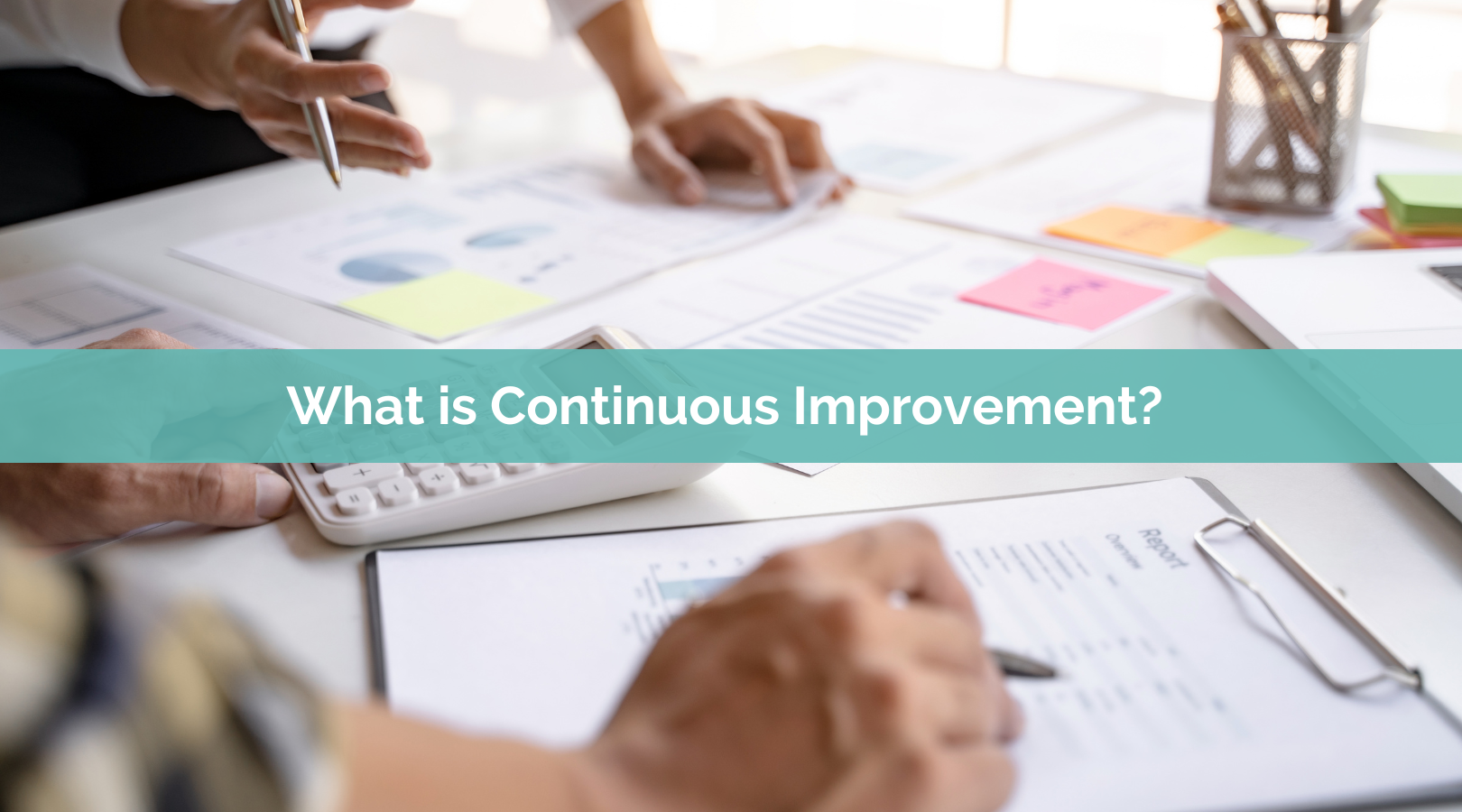
In the realm of modern business, the quest for excellence is a journey rather than a destination. The continual improvement process serves as the compass guiding organizations toward enhanced efficiency, heightened customer satisfaction, and sustainable growth. In this blog, we’ll discuss the details of continual improvement, understand its significance, and delve into its remarkable benefits.
What is Continuous Improvement?
Continual improvement, often synonymous with continuous process improvement, embodies an unwavering commitment to refining operations, products, or services. It encompasses a systematic approach that thrives on incremental enhancements and the pursuit of excellence. This process becomes ingrained in an organization's culture, fueling progress as a perpetual force.
Why Use a Continuous Improvement Process?
The adoption of a continuous improvement process is a strategic choice that yields far-reaching advantages, making it a cornerstone of modern business strategies. Here's why it is not just a choice, but a necessity:
- Increased Efficiency and Productivity: The continuous improvement process operates as a watchful guardian against inefficiencies, helping your company identify areas for refinement and optimization. By targeting bottlenecks, redundancies, and workflow obstacles, organizations can streamline processes, making better use of time and resources.
- Improved Customer Experience: Businesses that are attuned to continuous improvement are naturally inclined to listen to their customers. By addressing pain points and aligning products and services with evolving needs, a seamless and tailored customer experience takes root.
- More Engaged and Empowered Workforce: When employees are empowered to contribute to the betterment of their work environment, a culture of engagement flourishes. The continual improvement process nurtures a sense of ownership, innovation, and collaboration among team members.
- Competitive Advantages: In a dynamic marketplace, adaptability is key. Organizations that embrace continuous improvement remain agile, ready to pivot and seize new opportunities. This proactive stance often translates into a significant competitive edge.
- Cost Savings: Pinpointing areas for optimization leads to cost savings. The process ensures that resources are allocated optimally, preventing wasted time, and supporting sustainable financial health.
What are the Steps of Continuous Process Improvement?
At the heart of the continual improvement process lies a structured and systematic approach that empowers organizations to elevate their performance, streamline operations, and foster innovation. This foundational framework is commonly known as the PDCA (Plan, Do, Check, Act) cycle—a perpetual sequence that serves as the guiding compass for ongoing enhancements. Let's explore each phase of this dynamic cycle in greater detail:

1. Plan: Envisioning the Path Forward
The inaugural step of the PDCA cycle is marked by meticulous planning. Here, the focus is on setting a robust foundation for improvement. Organizations delve into an in-depth assessment of their current state, recognizing existing strengths and areas needing refinement. Objectives are defined with precision, serving as beacons that illuminate the path toward advancement.
This planning stage involves:
- Objective Identification: Clearly define the goals and objectives of the improvement initiative. These objectives act as signposts, providing a clear direction for the entire process.
- Current State Analysis: Scrutinize the existing processes, identifying bottlenecks, inefficiencies, and opportunities for optimization. Understanding the present state is crucial for informed decision-making.
- Roadmap Creation: Develop a comprehensive roadmap outlining the journey from the current state to the desired future state. This roadmap serves as a blueprint for the subsequent phases of the cycle.
In essence, the planning phase is akin to charting a course for a voyage of progress—a course that is rooted in a deep understanding of where the organization stands and where it aspires to be.
2. Do: The Power of Action
Armed with a well-crafted improvement plan, the focus shifts from contemplation to action. This phase is characterized by the tangible implementation of the proposed changes and improvements. It is the stage where ideas become reality and where strategies find their expression in the operational landscape.
The "Do" phase encompasses:
- Implementation: Execute the strategies and changes outlined in the plan. This could involve revamping processes, adopting new technologies, or introducing innovative methodologies.
- Resource Allocation: Allocate the necessary resources—be it manpower, time, or technology—to ensure the successful execution of the proposed changes.
- Collaboration: Encourage cross-functional collaboration to ensure a seamless and synchronized implementation. Communication and teamwork play a pivotal role in this phase.
The "Do" phase embodies the spirit of transformation, where theoretical concepts become tangible actions that have the potential to reshape the organization's trajectory.
3. Check: Navigating by Data
As the wheels of change are set in motion, the "Check" phase assumes center stage. This phase is characterized by a vigilant and data-driven evaluation of the impact of the implemented changes. It is a pivotal stage that provides insights into the efficacy of the improvements and sheds light on whether the desired outcomes are being achieved.
Key activities during the "Check" phase include:
- Data Collection: Gather relevant data and metrics that offer a quantitative assessment of the changes. This data serves as a critical yardstick for measuring progress.
- Analysis: Thoroughly analyze the collected data, comparing it against the predetermined benchmarks and objectives established during the planning phase.
- Insight Generation: Extract meaningful insights from the analysis. Identify areas of success, pinpoint any deviations, and unearth patterns that provide a deeper understanding of the outcomes.
The "Check" phase embodies the spirit of scrutiny—a meticulous examination of data that guides informed decision-making and shapes the trajectory of future enhancements.
4. Act: The Cycle of Refinement
Informed by the insights gleaned from the "Check" phase, the "Act" phase ushers in a cycle of refinement. This phase is all about taking deliberate and strategic actions based on the evaluation results. It involves capitalizing on successes, addressing shortcomings, and fine-tuning the processes for optimal outcomes.
During the "Act" phase, organizations:
- Adjust and Refine: Make necessary adjustments based on the analysis of data. Address any discrepancies between actual outcomes and desired objectives.
- Optimize Processes: Identify opportunities for further enhancement. Explore ways to optimize processes, streamline workflows, and capitalize on successful strategies.
- Continuous Learning: Encourage a culture of learning and adaptation. Share insights gained from the "Check" phase with the broader team, fostering a collective understanding of the improvement process.
The "Act" phase is akin to the rudder of a ship—a tool that steers the course based on real-time insights, ensuring the continual fine-tuning and evolution of the organization's operations.
The PDCA cycle, with its four interlinked phases—Plan, Do, Check, Act—embodies the essence of the continual improvement process. It's a journey that organizations embark upon with the intention of not just achieving excellence, but of maintaining and perpetuating it. As each cycle unfolds, the organization's knowledge deepens, its strategies become more refined, and its trajectory toward progress becomes increasingly sure-footed. In an era of relentless change, the PDCA cycle stands as a beacon of consistency—a framework that empowers organizations to navigate complexity, adapt to challenges, and thrive in the pursuit of excellence.
Leveraging ENSUR for Seamless Continuous Improvement
In the ever-evolving landscape of business, the quest for continuous improvement is a hallmark of success. As organizations navigate complexities, embrace technological advancements, and seek to optimize their operations, a reliable ally emerges on the horizon – ENSUR Document Management. This innovative DMS platform not only aligns with the principles of continuous improvement but also empowers businesses to harness its transformative potential with unparalleled efficiency.
ENSUR, a robust and dynamic document and quality management system, serves as a catalyst for organizations aiming to streamline their processes, enhance customer experiences, and foster a culture of innovation. With its comprehensive suite of features, ENSUR offers a holistic approach to continuous improvement, enabling businesses to navigate the PDCA cycle (Plan, Do, Check, Act) seamlessly.
The Plan phase finds its perfect companion in ENSUR, as it provides a structured framework to set objectives, define improvement strategies, and establish a roadmap for change. The platform's intuitive interface empowers teams to collaboratively chart the course toward progress, ensuring that every stakeholder is aligned and informed.
In the Do phase, ENSUR's versatility shines as it facilitates the implementation of proposed changes with precision. From process optimization to technology adoption, ENSUR empowers organizations to translate plans into action, fostering a culture of dynamic execution and innovation.
As organizations progress to the Check phase, ENSUR becomes an invaluable asset in data-driven decision-making. By capturing and analyzing critical metrics, the platform empowers teams to assess the impact of implemented changes. The insights garnered from ENSUR's robust analytics serve as guiding lights, illuminating the path toward refinement.
Finally, the Act phase finds resonance in ENSUR's adaptability. The document management platform empowers organizations to adjust strategies, refine processes, and optimize workflows based on real-time insights. Through iterative cycles of improvement, ENSUR ensures that the pursuit of excellence becomes an ingrained practice.
ENSUR's role in continuous improvement transcends mere technological assistance; it becomes a driving force, a reliable partner, and a source of transformation. By seamlessly integrating with an organization's culture, ENSUR nurtures a mindset of perpetual enhancement, empowering teams to embrace change, drive innovation, and navigate the seas of progress.
Embrace ENSUR and embark on a journey of continual improvement that propels your organization to new heights of excellence. Contact us today to learn more.
.png?width=4000&height=600&name=Blog%20Author%20Headers%20(5).png)
Chad Bouley is the Technical Support Manager at DocXellent, involved in all aspects of the software lifecycle. With over 20 years of experience in the technology industry, he excels in problem-solving and oversees professional services like data migrations. He values the collaborative and family-friendly environment at DocXellent and takes pride in contributing to the company's success. When not at work, Chad enjoys spending time with his family and playing Hearthstone. Learn more about Chad here.




























